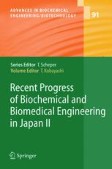Search
Search Results
-
Fluorescence Correlation Spectroscopy with Autofluorescent Proteins
Fluorescence correlation spectroscopy (FCS) is a versatile technique operating at the single-molecule level, that successfully meets many challenges...
-
Inclusion Bodies: Formation and Utilisation
The efficient in vivo folding of many heterologous proteins is a major bottleneck of high level production in bacterial hosts and simple optimisation...
-
The Application of Multi-Parameter Flow Cytometry to Monitor Individual Microbial Cell Physiological State
The development of multi-parameter flow cytometric techniques in our laboratories has led to a functional classification of the physiological state...
-
Roles of Heat-Shock Chaperones in the Production of Recombinant Proteins in Escherichia coli
Escherichia coli is a versatile organism for the production of recombinant proteins. Often, however, the recombinant protein does not reach its...
-
Bacterial Sterilization and Intracellular Protein Release by a Pulsed Electric Field
Several biotechnological applications of high-voltage pulsed electric field (PEF) are introduced. Electrical breakdown or disruption of a biological...
-
Functional Magnetic Particles for Medical Application
Magnetic particles for medical applications have been developed by many researchers. Since magnetic particles have unique magnetic features not...
-
Regulation of Cephalosporin Biosynthesis
The filamentous fungus Acremonium chrysogenum is the natural producer of the β-lactam antibiotic cephalosporin C and is as such used worldwide in...
-
Facts and Theories of Induced Organ Regeneration
Induced organ regeneration is de novo synthesis of a physiological, or nearly physiological, organ at the same anatomical site as the organ that is...
-
Lentiviral Vectors
We review the use of lentiviral vectors in current human gene therapy applications that involve genetic modification of nondividing tissues with...
-
Plasmid Vaccines and Therapeutics: From Design to Applications
In the late 1980s, Vical and collaborators discovered that the injection into tissues of unformulated plasmid encoding various proteins resulted in...
-
Adeno-associated Virus as a Gene Therapy Vector: Vector Development, Production and Clinical Applications
Adeno-associated virus (AAV) has emerged as an attractive vector for gene therapy. AAV vectors have successfully been utilized to promote...
-
Fluorescence Recovery after Photobleaching: Application to Nuclear Proteins
Fluorescence redistribution after photobleaching (FRAP) has received increasing attention ever since it was first introduced into cell biological...
-
Screening for New Metabolites from Marine Microorganisms
This article gives an overview of current analysis techniques for the screening and the activity analysis of metabolites from marine...
-
Extreme Environments as a Resource for Microorganisms and Novel Biocatalysts
The steady increase in the number of newly isolated extremophilic microorganisms and the discovery of their enzymes by academic and industrial...
-
Seafood Allergy: Lessons from Clinical Symptoms, Immunological Mechanisms and Molecular Biology
Food allergy consists of a wide range of disorders that result from adverse immune responses to dietary antigens. Manifestations of allergic...
-
Asymmetric Total Synthesis of Complex Marine Natural Products
Among nature's ecosystems, the marine environment has been an extremely rich source of structurally complex and biologically active molecules. This...
-
Trends and Challenges in Enzyme Technology
Several major developments took place in the field of biocatalysis over the past few years. These include the invention of directed evolution...
-
Microbial Isoprenoid Production: An Example of Green Chemistry through Metabolic Engineering
Saving energy, cost efficiency, producing less waste, improving the biodegradability of products, potential for producing novel and complex...
-
Large-Scale Production of Hairy Root
Many products of interest are synthesized in organized tissues, but not formed in suspension or callus culture. Therefore, most attention has been...
-
Aquaculture of “Non-Food Organisms” for Natural Substance Production
Marine invertebrates are already sources of commercially important secondary metabolites and may become even more so as knowledge on marine...
